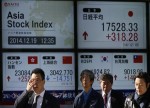
- All Instrument Types
- Indices
- Equities
- ETFs
- Funds
- Commodities
- Currencies
- Crypto
- Bonds
- Certificates
Please try another search

ETFs To The Rescue As Coronavirus Fears Beat US Stimulus Flows

The coronavirus-led stock market rout continues. The Dow Jones Industrial Average slid 6.30% to close at 19,898.92 on Mar 18. Yesterday’s fall is said to have wiped out all the gains witnessed by the blue-chip index since President Trump took office. After the S&P 500 had declined 7% from its Tuesday close on Mar 18, an exchange-mandated circuit breaker paused trading for 15 minutes for the second time in three days. Eventually, the S&P 500 and the Nasdaq Composite ended yesterday’s trading session after falling 5.2% and 4.7%, respectively (read: Has Wall Street's March Madness Peaked? ETFs to Tap).
The U.S. government and the central bank seem to be making a lot of efforts to support the economy during the current turbulent situation. The central bank surprised Wall Street by slashing its interest-rate target range of 0-0.25%. This marks the second emergency cut in less than two weeks’ time. The Fed also launched a quantitative-easing program of at least $700 billion. The central bank will buy at least $500 billion in Treasury securities and at least $200 billion in mortgage-backed securities in the coming months.
The U.S. Senate has cleared the second major bill at $1.3 trillion to combat the coronavirus epidemic. Per an article published in The Guardian, the U.S. government has announced plans to send cheques directly to American citizens as an emergency financial aid.The White House has also planned to allow individual taxpayers to defer payments of up to $1 million and for companies of up to $10 million (read: ETFs to the Rescue Amid Coronavirus-Led Volatility).
The rising coronavirus-led shutdowns have been escalating worries among market participants in the United States, as more than 8,700 people have tested positive and around 150 have died. All 50 states in the United States and the District of Columbia have confirmed cases of coronavirus. The rapid spread of the virus is leading to sweeping travel bans, and cancellation of large events as well as shutting down of schools, colleges, universities, restaurants and bars and shopping malls. In such a scenario, slowing global economic growth looks inevitable. In such a scenario, JPMorgan (NYSE:JPM) estimates that a recession will hit the U.S. and European economies by July. According to this financial services company, the U.S. economy may contract 2% in the first quarter and 3% in the second (read: Coronavirus Panic to Send Economy Into Recession: ETF Picks).
In such a scenario, investors can take a look at the following ETF areas to combat the ongoing coronavirus crisis:
Treasury ETFs
Investors’ risk-off sentiments, along with the global stimulus packages, in order to protect the economy from the rapidly-aggravating coronavirus outbreak has sparked huge rally in Treasuries. As such, investors can tap the opportunity by going long on this instrument with the help of ETFs like iShares 20+ Year Treasury Bond (NASDAQ:TLT) ETF (NZ:TLT) , iShares 7-10 Year Treasury Bond (NYSE:IEF) ETF IEF, iShares Short Treasury Bond ETF (ASX:SHV) , iShares 1-3 Year Treasury Bond ETF SHY and iShares U.S. Treasury Bond ETF GOVT (read: Bears Grip Market: 5 Safe ETF Investing Zones).
Inverse ETFs
The virus-induced volatility is spurring demand for inverse or inverse-leveraged ETFs. These products either create a short position or a leveraged short position in the underlying index through the use of swaps, options, future contracts and other financial instruments. Due to their compounding effect, investors can earn higher returns in a shorter period of time, provided the trend remains favorable. However, these funds run the risk of huge losses compared with traditional funds in fluctuating markets. So, investors intending to play against the tumbling Dow Jones, may tap ProShares Short Dow 30 DOG, ProShares UltraShort Dow30 DXD and ProShares UltraPro Short Dow30 SDOW (read: Coronavirus Triggers Market Bloodbath: 7 Hot Inverse ETF Areas).
Dividend ETFs
In a low-interest rate environment, dividend investing becomes a hot spot. Against this backdrop, dividend ETFs like WisdomTree U.S. Quality Dividend Growth Fund DGRW, FlexShares Quality Dividend Defensive Index Fund QDEF, WBI Power Factor High Dividend ETF WBIY and Schwab US Dividend Equity ETF SCHD might be compelling picks (read: 7 Dividend ETFs That Offer Growth in 2020).
Consumer Staple ETFs
This non-cyclical sector is likely to be less hammered by any market crash. The sector can emerge as a true safe haven amid the latest crisis as even people on self-quarantine need daily essentials. Investors can consider The Consumer Staples Select Sector SPDR Fund XLP, Vanguard Consumer Staples ETF VDC, iShares U.S. Consumer Goods ETF IYK and Invesco S&P 500 Equal Weight Consumer Staples ETF RHS (read: Beat Virus With 2 Sector ETFs & Stocks That Survived 2008 Crisis).
Want key ETF info delivered straight to your inbox?
Zacks’ free Fund Newsletter will brief you on top news and analysis, as well as top-performing ETFs, each week. Get it free >>
iShares 20+ Year Treasury Bond ETF (TLT): ETF Research Reports
Consumer Staples Select Sector SPDR ETF (NYSE:XLP): ETF Research Reports
iShares 7-10 Year Treasury Bond ETF (IEF): ETF Research Reports
Invesco S&P 500 Equal Weight Consumer Staples ETF (RHS): ETF Research Reports
iShares U.S. Treasury Bond ETF (GOVT): ETF Research Reports
WisdomTree U.S. Quality Dividend Growth ETF (DGRW): ETF Research Reports
Proshares Short Dow30 (DOG): ETF Research Reports
Vanguard Consumer Staples ETF (VDC): ETF Research Reports
iShares Short Treasury Bond ETF (SHV): ETF Research Reports
FlexShares Quality Dividend Defensive ETF (QDEF): ETF Research Reports
ProShares UltraPro Short Dow30 (SDOW): ETF Research Reports
iShares U.S. Consumer Goods ETF (IYK): ETF Research Reports
iShares 1-3 Year Treasury Bond ETF (SHY): ETF Research Reports
WBI Power Factor High Dividend ETF (WBIY): ETF Research Reports
ProShares UltraShort Dow30 (DXD): ETF Research Reports
Original post
Zacks Investment Research
Related Articles

Since the Robotaxi event on October 11th, Tesla (NASDAQ:TSLA) stock is up 38%, currently priced at $291.60 per share This is a return to the early November 2024 price level. But...

The Q4 2024 earnings season tapers off from here, with S&P 500® EPS growth surpassing 17%, the highest in 3 years Large cap outlier earnings dates this week include:...

Shares of Alibaba (NYSE:BABA) are on a tear to start off 2025. The consumer discretionary and tech stock is up by 52% this year as of the Feb. 25 close. The company’s cloud...
Are you sure you want to block %USER_NAME%?
By doing so, you and %USER_NAME% will not be able to see any of each other's Investing.com's posts.
%USER_NAME% was successfully added to your Block List
Since you’ve just unblocked this person, you must wait 48 hours before renewing the block.
I feel that this comment is:
Thank You!
Your report has been sent to our moderators for review





Add a Comment
We encourage you to use comments to engage with other users, share your perspective and ask questions of authors and each other. However, in order to maintain the high level of discourse we’ve all come to value and expect, please keep the following criteria in mind:
Enrich the conversation, don’t trash it.
Stay focused and on track. Only post material that’s relevant to the topic being discussed.
Be respectful. Even negative opinions can be framed positively and diplomatically. Avoid profanity, slander or personal attacks directed at an author or another user. Racism, sexism and other forms of discrimination will not be tolerated.
Perpetrators of spam or abuse will be deleted from the site and prohibited from future registration at Investing.com’s discretion.